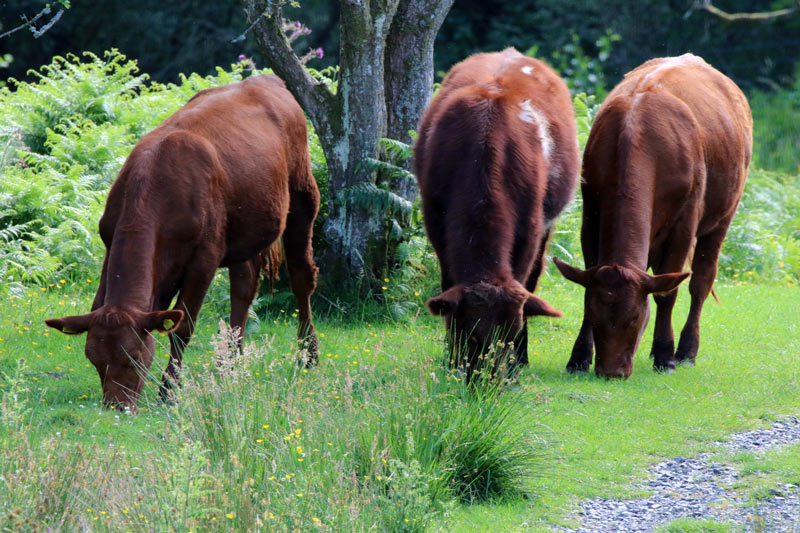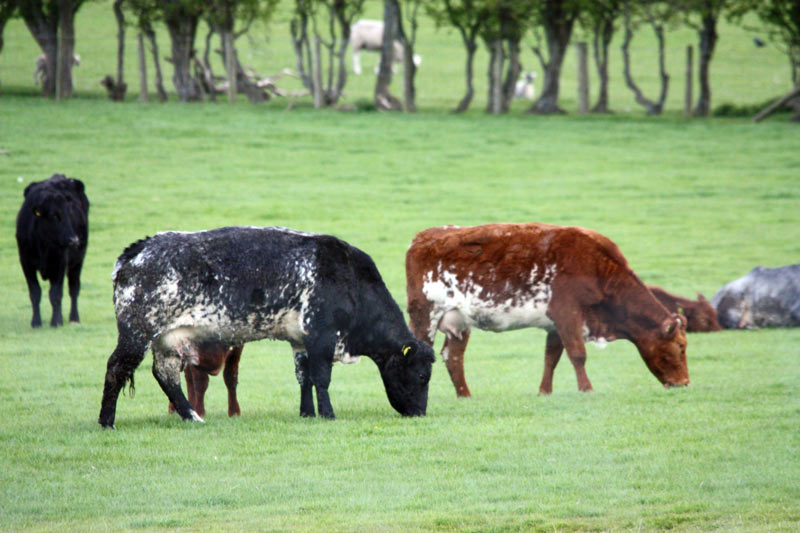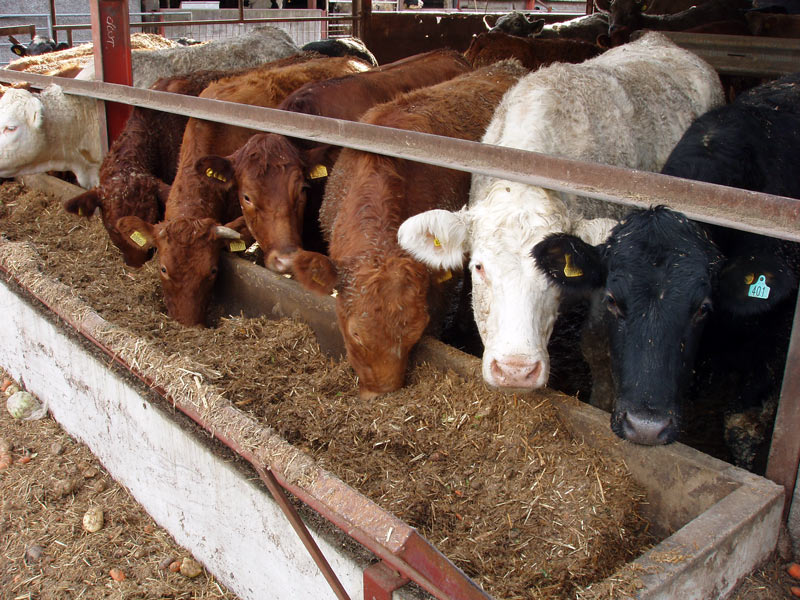Target Setting
Setting targets is important if cash flow and profit & loss forecasts are to be met.
Checking the current performance standards is a pretty good base to start from. Check on current slaughter weights, carcass weights and EC fat class classification levels, and decide what needs to be improved on and what factors have been responsible for impeding performance.
Setting performance targets
This is a relatively simple but important task, vital if the enterprise is to be properly budgeted. (see Table X)
Table X
| Start weight | – |
| Final weight | – |
| Average weight | – |
| Total weight gain | – |
| Number of days required to finish | – |
| Target daily liveweight gain | – |
The next step in planning has to be assessment of the feed requirements for the job. In order to do this, we need to know the following information as shown in table Y.
Table Y
| – | Feed Analysis | Daily Ration | Feed Budget | ||||||
| Feed available | DM(%) | ME (MJ/Kg DM) | CP (%) | DM (Kg) | ME (MJ) | CP (grams) | Fresh Weight (Kg) | Feed Quantities | |
| – | – | – | – | – | – | – | – | Per head (Kg) | Total (Tonnes) |
| Concentrates | |||||||||
| – | – | – | – | – | – | – | – | – | – |
| – | – | – | – | – | – | – | – | – | – |
| – | – | – | – | – | – | – | – | – | – |
| Forages | |||||||||
| – | – | – | – | – | – | – | – | – | – |
| – | – | – | – | – | – | – | – | – | – |
| – | – | – | – | – | – | – | – | – | – |
Some consideration should be given to the system best suited for the type of farm, buildings, forage quality and availability and the returns needed.
Planning this is a much more subjective process. Personal preferences are important here but have to be kept realistic.
I suggest that a good place to start is by looking closely at the type of animal that is best suited to your inputs.
Early maturing UK Beef breeds are well suited to the low input forage-based systems but have a tendency to get fat easily. Big Continental breeds tend to need a more concentrated ration if they are to be finished at the best marketing weights. The UK Breed / Continental cross is probably the most popular type of beef animal because it falls nicely between the extremes.
Looking at birth weights of typical breeds of cattle will give a good indication of the variation expected in the natural mature weights.
Table 2 shows the average birth weights of common breeds of cattle. These weights are directly related to the mature animal weights of the same breeds. Genetic progress has generally resulted in small increases in birthweights over the years, but these averages are not far off the mark!
When selecting crosses the ease of fattening needs to be closely considered, for example Ayrshire cross beef will fatten earlier and much more easily than Holstein cross beef.
Table 2
Calf Birth Weights of Common Breeds of Cattle
AFRC 1992 and other sources breed averages show a wide variance on mature cow weights.
| Breed of Sire | Bull Calf | Heifer Calf | Average | Mature Dam Weight | |
| Angus | 28 | 26 | 27.1 | Angus | 550 |
| Ayrshire | 35 | 32.6 | 33.8 | Ayrshire | 525 |
| Charolais | 44 | 40.9 | 42.5 | Charolais | 800 |
| Friesian | 39 | 36.3 | 37.6 | Friesian | 617 |
| Guernsey | 33 | 30.7 | 31.9 | Guernsey | 475 |
| Galloway | 29 | 27.4 | 28.2 | Galloway | 520 |
| Hereford | 26 | 33.5 | 34.8 | Hereford | 540 |
| Holstein | 45 | 41.9 | 43 | Holstein | 720 |
| Jersey | 26 | 24.2 | 25.1 | Jersey | 450 |
| Limousin | 39 | 36.3 | 37.7 | Limousin | 650 |
| Belgian Blue | 51.6 | 47.6 | 49.2 | Belgian Blue | 780 |
| Simmental | 44 | 40.9 | 42.5 | Simmental | 680 |
Twins = Single Calf Weight x 1.75
Energy requirements are based on the bull calf weight given above divided by 40 x the calculated requirement for the 40 kg calf.
Table 3a
Slaughter weights of cereal beef (bulls)
10 – 14 months (Slaughtered at fat class 3)
| Breed/Cross | Slaughter Weight |
| Friesian x Holstein* (F) | 460 |
| Aberdeen Angus/Hereford x Friesian (AA x F, He x F) | Not recommended |
| Belgian Blue x Friesian (BB x F) | 500 |
| Simmental x Charolais (S x F, Ch x F) | 520 |
| Limousin x Friesian** (L x F) | 490 |
* Only Recommended system for this cross
** Most popular dairy cross for beef
Table 3 a (above) shows slaughter weights based on required carcass weights and conformation to supply the meat chain with their required meat cut sizes. There is also some requirement for larger animals and these tend to be required by individual butchers rather than the mass market chain.
*EC Carcass classification scheme.
In the E C scheme, the carcases are classified on a scale 1(Leanest), 2, 3, 4L, 4H, 5L, 5H (Fattest). Preferred fat classes 3 and 4L have a back-fat thickness of about 3 mm and 4.5 mm respectively.
Body Condition Scoring
Body condition score represents a pretty good indication of nutritional status. The assessment of condition should therefore be used to plan feeding management.
Body condition score is based on a system of inspection and handling on a scale 1 (Thin) to 5 (Fat).
The technique is to grip the loin with the thumb curled under the edge of the transverse processes of the spine and use the ball of the thumb to feel the fat thickness over the bone.
| Score 1 | Bony with no detectable fat cover |
| Score 2 | The bones of the transverse processes can be felt but they are rounded by a thin fat cover. |
| Score 3 | The transverse processes can only be felt with firm pressure. |
| Score 4 | The bone cannot be felt even with firm pressure. |
| Score 5 | The cow is obviously very fat with puffy deposits around the tail head. |
The suckler cow should vary in score between 2 and 3 according to her cycle and stage of pregnancy. In practice, many suckler cows tend to be 3 to 4L to H.
| Season | Target Score | Spring Calver | Autumn Calver |
| Spring | 3 | Calving | Pregnant / Suckling |
| Summer | 2.5 | Bulling / Suckling | Weaning |
| Autumn | 3 | Weaning | Calving |
| Winter | 3 | Pregnant / Dry | Bulling / Suckling |


The Tables below from 3b to 3e show the typical slaughter weights achieved according to the rate of daily live weight gain for four different finishing systems.
At first glance the tables don’t look logical with faster growing animals being killed at lower carcass weights. The reason for this is that they achieve the right conformation and fat class earlier than slower growing animals which achieve their correct fat class at higher carcass weights. (see notes below)
Housed cattle on silage & concentrates, mainly bulls but also steers & heifers.
Table 3b
Slaughter weights of beef from grass & maize silage
12 – 18 Months
| Daily gain from three months (Kg) | ||||||||
| 0.8 | 0.9 | 1 | 1.1 | 1.2 | 1.3 | |||
| Breed | Sex | Fat Class | ||||||
| F* | Bull | 3 | – | 520 | 515 | 505 | 490 | 475 |
| – | Steer | 3/4L | 510 | 500 | 485 | 460 | – | – |
| – | Heifer | 4L | 460 | 475 | – | – | – | – |
| He x F | Bull | 3 | 500 | 490 | 475 | 460 | – | – |
| – | Steer | 4L | 475 | 460 | 440 | – | – | – |
| – | Heifer | 4L | 410 | 370 | – | – | – | – |
| BB x F | Bull | 3 | – | 560 | 550 | 540 | 525 | 510 |
| – | Steer | 3/4L | 540 | 530 | 520 | 505 | 490 | – |
| – | Heifer | 4L | 480 | 465 | 445 | – | – | – |
| CH x F S x F |
Bull | 3 | – | 575 | 565 | 555 | 540 | 525 |
| – | Steer | 3/4L | 560 | 550 | 535 | 520 | 490 | – |
| – | Heifer | 4L | 500 | 485 | 460 | – | – | – |
| L x F | Bull | 3 | – | 545 | 540 | 530 | 520 | 505 |
| – | Steer | 3/4L | 535 | 525 | 515 | 505 | 490 | – |
| – | Heifer | 4L | 480 | 460 | 440 | – | – | – |
* Note this system is not particularly good for Holstein beef, the poor confirmation and high maturity weight of the dairy character of the Holstein means that they will tend to grow lean rather than fat, and hence take longer to finish. Animals which exhibit the blockier Friesian type conformation tend to be better suited to the system.
It is the case in all the crosses that exhibit the more traditional the Friesian conformation : the better the resulting conformation and killing out weight at finish.
Table 3c
Classic 18 Month Beef
15 to 20 months
Autumn born dairy bred calves, reared in the first winter, grazed and finished in the second winter on silage and concentrates. Steers and heifers.
| Daily gain in finishing winter period (Kg) | ||||||||
| 0.7 | 0.8 | 0.9 | 1 | 1.1 | 1.2 | |||
| Breed | Sex | Fat Class | ||||||
| F | Steer | 4L | – | 520 | 510 | 490 | 470 | – |
| – | Heifer | 4L | 480 | 465 | 450 | – | – | – |
| He x F | Steer | 4L | 500 | 480 | 460 | 440 | – | – |
| – | Heifer | 3/4L | 435 | 415 | 375 | – | – | – |
| BB x F | Steer | 3/4L | – | 550 | 535 | 525 | 510 | – |
| – | Heifer | 4L | 490 | 485 | 470 | 450 | – | – |
| CH x F S x F |
Steer | 3/4L | – | 570 | 560 | 545 | 525 | 500 |
| – | Heifer | 4L | 500 | 495 | 485 | 455 | – | – |
| L x F* | Steer | 3/4L | – | 545 | 535 | 530 | 520 | 500 |
| – | Heifer | 4L | 485 | 480 | 465 | 445 | – | – |
L x F* This system is extremely popular with the main autumn calving dairy herds in the west.
there is a good level of reliability in the system and the animals tend to come through with a surprising evenness of character.

Table 3d
Winter finishing of suckled calves and stores
15 to 26 months
Suckled calves up to 1 year and stores 15 to 20 months fed rationed concentrates and silage to appetite.
Older stores are also fed on the same system to finish at 20 to 26 months, usually after the second subsidy has been drawn.
| Daily gain in finishing (Kg) to fat class 4L | |||||||
| 0.7 | 0.8 | 0.9 | 1.0 | 1.1 | 1.2 | ||
| Slaughter weight | |||||||
| UK breeds & crosses (light weight, e.g. Hereford, Angus, Galloway, Welsh Black etc.) | |||||||
| Suckled Calf | Steer | 486 | 475 | 455 | 425 | – | – |
| – | Heifer | 415 | 405 | 375 | – | – | – |
| Older Store | Steer | 510 | 500 | 475 | 445 | – | – |
| – | Heifer | 435 | 425 | 400 | – | – | – |
| Continental breeds & crosses ( heavy weight, e.g. Charolais, Simmental, Limousin, etc.) | |||||||
| Suckled Calf | Steer | – | 540 | 535 | 525 | 515 | 490 |
| – | Heifer | 475 | 465 | 450 | 425 | – | – |
| Older Store | Steer | – | 575 | 570 | 560 | 550 | 530 |
| – | Heifer | 500 | 490 | 475 | 450 | – | – |
There are many variations on this basic system; some farmers use home grown roots and turnips to supplement the silage, some use Draft or Brewers Grains, and some prefer to base the finishing ration on other bought in feeds from the human food processing industries.
Table 3e
Suckler Bull Beef
10 to 12 Months or 14 to 18 months
| – | Daily Gain | 1.0 | 1.1 | 1.2 | 1.3 | 1.4 | 1.5 |
| Slaughter Weight (Kg) | |||||||
| UK Breed/Cross EC fat class 3 to 4 L. | 475 | 470 | 460 | 440 | – | – | |
| Continentals & Crosses EC Fat class 3 | 530 | 525 | 520 | 515 | 500 | 485 | |
Fattening Notes:
- The speed at which cattle fatten is directly related to the rate of daily liveweight gain. As the rate of daily gain increases so does the rate of fat cover.
I am sure that this can be manipulated by dietary adjustment. - Cattle do not normally finish quickly; this means that there can be quite a range in possible slaughter weights within a particular EC fat class for the same type of cross. This will be directly related to the type and quality of diet that the animal is reared on.
- The difference in rate of fattening has major effects on the normal slaughter weights at fat classes 3 and 4 L. Most buyers are looking for cattle that will classify as 3 and 4 L.
- Continental crosses tend to mature later and heavier so in order to provide a 3 to 4 L carcass at the required weight, the animal has to be finished light for its breed. This means that the continental type cross is more suited to the intensive systems with high target daily liveweight gains, like the cereal beef system.
- Conversely early maturing, light weight British breed crosses are much better suited to high forage systems with lower liveweight gains in order to avoid the carcass from becoming over fat to quickly.
- Individual animals can show considerable variance in performance from the group. Regular assessment of the individual is important in order to select the optimum feeding regime for the animals concerned. Regular weighing and handling in order to determine the right moment to market the animal at its optimum weight and class, is essential if the best prices are to be obtained.
- Slow growers are usually pretty inefficient at converting food into liveweight gain and are best slaughtered at the bottom of the fat class in order to prevent them from losing too much money as they slowly increase in weight.
- Fast growers should be allowed to get to the higher weights within the target fat class, because if they are converting feed into liveweight efficiently, they will be contributing profit.
- Selecting and targeting animals for system and marketing weights in this way will reduce inefficient feed use and help to maximise profit by reducing feed costs.
Storing Cattle
Cattle are normally stored in the winter in order to be grazed the following season. This sounds pretty obvious, but the main object in storing cattle is to take advantage of the extra compensatory growth from the highly digestible high value spring grass.
This is very desirable since the grass is much cheaper and more effective for finishing cattle, than the conserved winter forages on their own. Feeding cattle too well in the winter generally depresses the gains from grass later on.
Table 4
Target over wintering (Store) cattle gains.
| – | Daily liveweight gain |
| Summer/Autumn born dairy bred calves. 1st rearing winter. | 0.8 Kg per day. |
| Suckled calves/store cattle for grass finishing. British breeds & crosses. | 0.4 to 0.6 Kg per day. |
| Continentals & crosses. | 0.6 to 0.8 Kg per day. |
